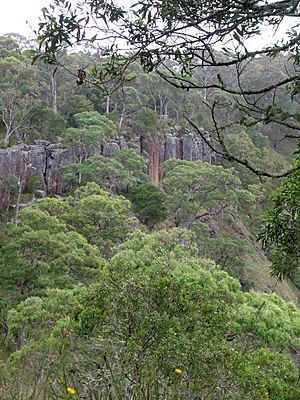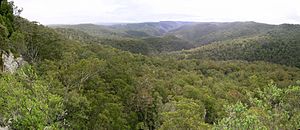Guy Fawkes River National Park facts for kids
Quick facts for kids Guy Fawkes River National ParkNew South Wales |
|
|---|---|
|
IUCN Category Ib (Wilderness Area)
|
|

Guy Fawkes River National Park, NSW
|
|
| Nearest town or city | Armidale |
| Established | 1972 |
| Area | 1,005.90 km2 (388.4 sq mi) |
| Managing authorities | NSW National Parks and Wildlife Service |
| Website | Guy Fawkes River National Park |
| See also | Protected areas of New South Wales |
Guy Fawkes River National Park is a large national park in New South Wales, Australia. It covers about 100,590 hectares, which is a huge area! You can find it where the New England Tablelands meet the Dorrigo Plateau, in the northeastern part of the state.
The park was created in 1972 to protect its amazing natural features and wildlife. It is managed by the NSW National Parks and Wildlife Service.
Contents
Getting to Guy Fawkes River National Park
You can reach the park from different directions. One common way is along Waterfall Way, near a town called Ebor. This spot is about 46 kilometres (29 miles) southwest of Dorrigo and 80 kilometres (50 miles) northeast of Armidale.
If you're coming from Sydney, the park is about 560 kilometres (348 miles) north. There are also other ways to get to more remote parts of the park, using roads like the Armidale-Grafton Road or the Old Grafton-Glen Innes Road.
Nature and Wildlife in the Park
Guy Fawkes River National Park is a very special place for nature. It has more than 40 different types of plant communities, which means you can see many kinds of trees, bushes, and flowers.
Plants and Animals
The park is home to 28 plant species and 24 animal species that are considered threatened. This means they are at risk of disappearing, so the park helps protect them. There are also large areas of very old forests, called old-growth forests, which are important habitats for many creatures.
Rivers and Gorges
The Guy Fawkes River is a main feature of the park. It dramatically drops off the Northern Tablelands at the Ebor Falls, creating a beautiful waterfall. The park also has spectacular valleys and rugged river gorges. These include the deeply cut Guy Fawkes River Valley, which follows an ancient fault line. Other rivers like the Aberfoyle, Sara, and Henry rivers also flow through these impressive gorges.
Wild Horses of the Park
Wild horses have lived in Guy Fawkes River National Park since the 1930s. These horses are special because they are believed to be direct descendants of Australia's wartime cavalry horses, known as Walers. Walers were famous for being strong and reliable horses used by soldiers.
Protecting Heritage Horses
In the early 2000s, there was a lot of discussion about how to manage these wild horses. People realized that these horses had important historical and cultural value. Because of their unique heritage, efforts began to humanely remove them from the park and find them new homes where they could be cared for.
The Guy Fawkes Heritage Horse Association (GFHHA) helps with this important work. They take care of horses that are gently removed from the park and offer them for sale to people who want to give them a good home. The association also works to keep the special characteristics and genetics of these wild horses safe. They even have a formal register and Stud Book to track them. The GFHHA also promotes how versatile these horses are by sponsoring events at local agricultural shows.
Bicentennial National Trail
In the 1970s, a long trail called the Bicentennial National Trail was planned. Part of this trail runs along the western side of the Guy Fawkes River. This section follows what used to be a travelling stock route, which was a path used to move livestock like cattle or sheep from one place to another.
See also
 In Spanish: Parque nacional Río Guy Fawkes para niños
In Spanish: Parque nacional Río Guy Fawkes para niños



